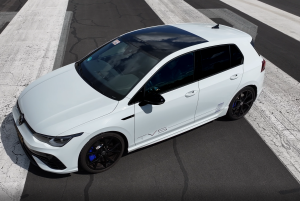SIMOS19 MQB EVO TECH POST – Intakes Part II
After releasing the first 2.0TSI EA888.4 EVO intake tech post TVS received many questions regarding other intake brands. So we decided to expand our research to generate a more complete overview of all available intake solutions for the new platform.
AFTERMARKET INTAKES
We first would like to thank the following companies for supplying their intakes for testing and development purposes. Summarized the following aftermarket intakes were compared to the stock Golf 8R intake system:
1. HF Series HFI Carbon Air Intake kit
2. REVO Carbon Series High Output Air Intake system
3. RacingLine R600 Air Intake
4. Eventuri Carbon Intake
TEST EQUIPMENT
As already described in our previous tech post the TVS development Golf Mk 8R is equipped with additional sensors through a Banks Power iDash Datamonster. This gives our engineers the possibility to analyze data that can’t be monitored on stock engine management. To acquire accurate data of the aftermarket intake systems an additional temperature and pressure sensor have been installed in the factory turbo inlet elbow. Both inputs are used by the Banks Power data acquisition system to calculate numerous parameters used in the comparison process. For example intake air system outlet density (IAS-OD) is calculated.
RESULTS
The results below are retrieved on dyno from the TVS development Golf 8R taking the following requirements into consideration where measuring conditions were kept similar at the start of every dyno run as much as possible:
- TVS Stage 2 EVO ECU software
- Stock hardware (only different intakes fitted on stock turbo inlet elbow)
- RON 98 fuel
- WOT dyno pulls performed in 4th gear
- Mean values of three dyno runs
Intake system outlet air density
A proper intake system design maintains the amount of air sucked from the environment by guiding the airflow with as less as possible restrictions and tries to maintain cool outside air temperature as it is ducted to the turbo. The most accurate measurement method for comparing the amount of air at the intake system outlet is air density.
For this reason TVS measured for every intake system outlet pressure and temperature within the stock factory turbo inlet elbow whereafter our datalogging equipment automatically calculates air density. Below is the measured air density [kg/100m3] plotted using the average data of three dyno runs per intake. This gives us a first insight into the performance of the different intake systems that have been tested on the TVS development Golf 8R. Basically the larger the negative slope of a curve is, the less ambient air is maintained from the intake outside duct to the turbo inlet, so the worse the intake system performance is.
However, based on above measured absolute air density no direct conclusions can be made. Since air density depends on environment pressure, temperature and humidity. So slightly different dyno room conditions do result into different initial air density values before the start of a measurement.
For a more accurate comparison even the slightest deviation in environment conditions need to be taken into consideration as well. Although dyno room conditions were kept similar as much as possible during there are always some slight differences. For this the Banks iDash datalogging equipment has the possibility to view the air density data normalized against the SAE J1349 standard as well (100%). SAE J1349 defines the amount of air an ambient pressure of 14.4 psia, an ambient temperature of 77 deg F, and a relative humidity of 0%.
The corrected SAE J1349 results above show a more reliable overview of the performance of the different tested aftermarket intakes for the new EA888.4 platform. As you can see the intakes do differ only a few percentages between each other, but all intakes do have a significant improvement over the stock intake.
Dyno results
Let’s see if the shown intake system outlet air density data matches the performance measured on dyno. The performance numbers below are DIN corrected wheel HP and Nm. Also here only small differences can be spotted and zooming in is needed for proper visualizing the measured performance differences. As the air density data already showed us, also the measured performance on dyno shows Eventuri is performing slightly better compared to REVO, HF Series and RacingLine.
CONCLUSION
The goal of this research was to publish an independent overview of more available intake solutions for the 2.0TSI EA888.4 platform. After testing, measuring and comparing data between the Eventuri, RacingLine, REVO and HF Series intake systems the statement “you get what you pay for” seems to be true.
Based on the measured data and dyno results we see the Eventuri intake is performing better compared to the RacingLine, REVO and HF Series one. However, the retail pricing for an Eventuri intake system is also around €1700 where you only pay about €1050 for the full REVO carbon intake system, €899 for the HF Series including German TÜV certification and around €800 for a RacingLine R600 intake system.
Based on your style preferences, market and budget you should choose the intake system that is most suitable for you. If budget doesn’t matter and you simply would like to have the best performance Eventuri is a proper decision. RacingLine, REVO and HF Series are almost performing identical, but the basic RacingLine intake system doesn’t have the more expensive carbon fiber looks which the REVO and HF Series one do have. For German customers the HF Series intake systems seems a wise choice looking at the included TÜV Certification.
We expect that the current small differences have a greater impact at higher performance levels. Stay tuned for results on 500+ HP!








